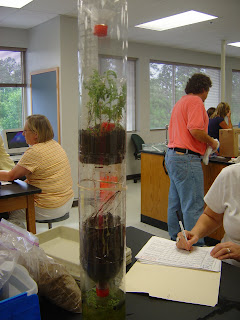
Creating an eco-column is a great way to get kids interested and involved in learning about ecosystems first hand. In the fifth grade comprehensive curriculum, Unit 5 on Ecosystems, there is an opportunity to use eco-columns. Students set up an ecosystem and try to keep it balanced for two weeks. Once they have made many observations and are able to recognize the living and non-living components of an ecosystem, they try to pollute it or see what happens if they remove one of the essential components of the ecosystem. I am anxious to see how everyone's ecocolumns evolve over time. This will give me valuable information for helping my students understand what is happening in their own ecosystems.
Observation: Day One--we have a tadpole, two minnows, and a snail in the aquatic part of our ecosystem. In addition, we have some duckweed and submerged aquatic vegetation. Unfortunately, we have lots of algae that will probably negatively affect the amount of dissolved oxygen in the bottom of the eco-column over time. We will see.....
In the second layer, we have a composting layer with layers of soil, humus, and more soil. We also have a small larva of some sort. We have plants in the terrestrial layer and are ready to go! It looks healthy today!











